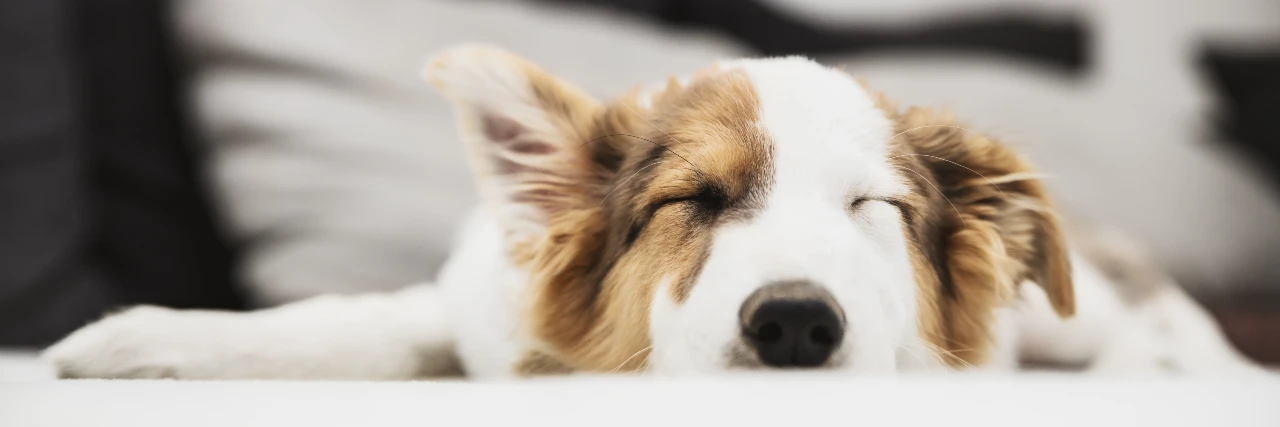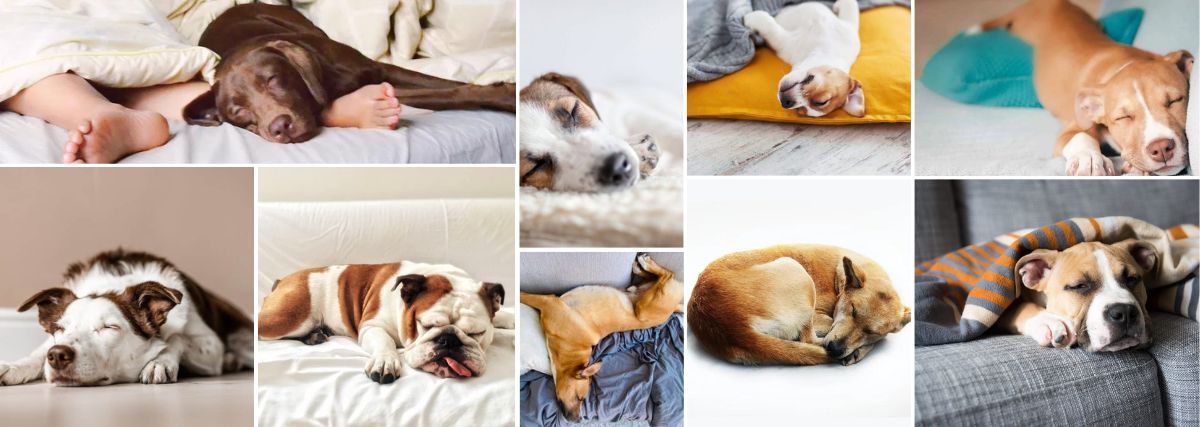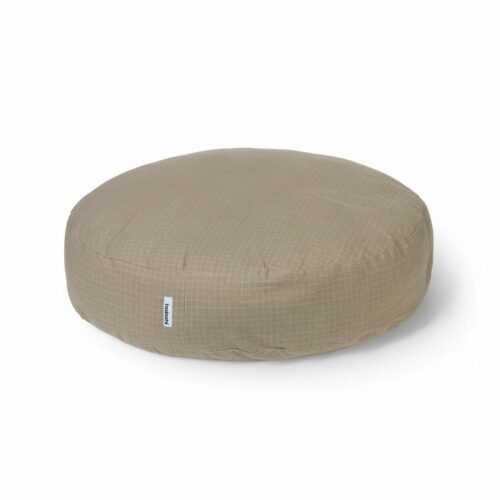Understanding Dog Sleep Patterns and 7 Tips for Optimal Dog Rest
Sleep plays a crucial role in our furry companions’ overall well-being, just as it does in our own lives. As dog owners, it’s important to understand the unique sleep patterns of our canine friends and how we can help them achieve restful slumber. In this blog post, we will delve into the science of dogs’ unique sleep patterns and provide practical tips to ensure your four-legged friend is well-rested and ready for the day’s adventures.
How Much Do Dogs Sleep? Understanding Your Canine Companion’s Sleep Duration
Research has revealed that dogs, like humans, go through distinct sleep-wake cycles. On average, adult dogs sleep for about 12 to 14 hours per day, while puppies and senior dogs may require even more sleep. It is important to note that dogs are diurnal animals, meaning that, like humans, they are active during the day and primarily sleep during the night. However, unlike humans, dogs have a polyphasic sleeping pattern and take multiple short naps throughout the day in addition to their night-time sleep. On average, dogs sleep for about 45 minutes per nap, while humans often sleep for seven to nine hours consecutively. Understanding your dog’s sleep duration and their polyphasic sleep pattern can help you establish a suitable routine to ensure they get sufficient rest.
What Are the Sleep Stages in Dogs? Exploring Light Sleep, Deep Sleep, and REM Sleep
Studies have identified different sleep stages in dogs, including light sleep, deep sleep, and rapid eye movement (REM) sleep. Just like us, dogs experience REM sleep, which is associated with dreaming and memory consolidation. During REM sleep, dogs may exhibit various behaviours, such as twitching, paw movements, and even vocalizations. It’s important not to interrupt your dog during this stage, as it plays a vital role in their cognitive function and overall well-being.

Improving Your Dog’s Rest: Factors That Affect Sleep Quality
Creating a peaceful sleep environment for your dog, which includes minimizing external noises and bright lights, is essential for promoting their restful slumber. Factors such as temperature, noise levels, and lighting significantly impact a dog’s sleep quality. Dogs are sensitive to temperature extremes, so ensuring a comfortable sleeping area with appropriate ventilation is crucial. Additionally, where your dog sleeps can also affect their sleep duration. Research shows that dogs who sleep indoors tend to sleep for around 80% of the night, while those who sleep outdoors may sleep for around 60% of the night. Therefore, providing a cosy and safe sleep environment indoors not only contributes to a more restful sleep but also helps regulate their sleep duration.
Do Dogs Experience Sleep Disorders? Common Sleep Issues in Canines:
Similar to humans, dogs can also experience sleep disorders that affect their sleep patterns and overall health. Common sleep disorders in dogs include insomnia, sleep apnoea, and restless leg syndrome. If you notice persistent changes in your dog’s sleep patterns, such as difficulty falling asleep or staying asleep, excessive daytime sleepiness, or restless nights, it’s recommended to consult your veterinarian. They can provide proper evaluation and guidance, which may include lifestyle adjustments, behavioural interventions, or medical treatment to improve your dog’s sleep quality.
Does Breed and Age Affect Dog Sleep?
Different dog breeds and age groups may exhibit variations in sleep patterns. Factors such as breed size, energy levels, and life stages can influence the amount of sleep dogs require and their sleep characteristics. For example, small breeds tend to have higher energy levels and may require more mental and physical stimulation during the day to achieve restful sleep at night. Puppies have different sleep needs compared to adult dogs, as they go through rapid growth and development, requiring more frequent naps throughout the day. On the other hand, senior dogs may benefit from additional orthopaedic support to alleviate any discomfort that can affect their sleep.

7 Tips for a Restful Slumber: Practical Advice for Promoting Your Dog’s Sleep
Consider your dog’s specific breed and age-related sleep requirements when designing their sleep routine and environment. Puppies and older dogs may have distinct needs compared to adult dogs. Providing appropriate bedding and ensuring a comfortable sleep environment tailored to their size and age can contribute to their overall restful slumber.
Here are some additional tips to help you manage the breed and age influence on your dog’s sleep:
- Monitor your dog’s activity level throughout the day and adjust their exercise routine accordingly. High-energy breeds may require more vigorous exercise sessions to tire them out, while lower-energy breeds may need gentle walks or mental stimulation activities to keep them engaged and prevent restlessness at night.
- Consider providing your dog with a variety of interactive toys and puzzles that engage their minds and provide mental stimulation. These activities can help tire them out mentally, promoting better sleep quality and reducing the likelihood of behavioural issues caused by boredom or excess energy.
- If you have a senior dog or a breed prone to joint issues, consider providing them with an orthopaedic bed or mattress that offers additional support and comfort. These beds are designed to alleviate pressure on joints and can be especially beneficial for dogs with arthritis or other age-related conditions.
- Pay attention to your dog’s feeding schedule. Avoid feeding them a large meal right before bedtime, as this can lead to discomfort and difficulty settling down for sleep. Instead, try to schedule their last meal of the day a few hours before bedtime, allowing ample time for digestion.
- Create a calming bedtime routine for your dog. Engage in relaxing activities such as gentle brushing or massage, which can help them unwind and signal that it’s time to wind down for sleep. Incorporating consistent cues like dimming the lights or playing soothing music can also help establish a sense of relaxation and promote better sleep.
- Practice positive reinforcement training methods to address any sleep-related behaviour issues. For example, if your dog tends to bark or become restless during the night, work on training techniques that encourage calm and quiet behaviour. Reward them for settling down and staying relaxed during sleep time.
- Consider consulting with a professional dog trainer or behaviorist if you’re experiencing persistent sleep-related challenges with your dog. They can provide personalized guidance and training strategies to address specific issues and help improve your dog’s sleep routine.
Remember, every dog is unique, and it may take some trial and error to find the strategies that work best for your furry friend. By paying attention to their individual needs, providing a comfortable sleep environment, and establishing a consistent routine, you can help ensure that your dog enjoys restful slumber and wakes up refreshed and ready for a new day.
References
- Accessed on May 30, 2023. https://pubmed.ncbi.nlm.nih.gov/29740040
- Accessed on May 30, 2023. https://pubmed.ncbi.nlm.nih.gov/32664232
- Accessed on May 30, 2022. https://pubmed.ncbi.nlm.nih.gov/27732667
- Accessed on May 30, 2022. https://www.sciencedirect.com/science/article/abs/pii/S1558787812000068
- Accessed on May 30, 2023. https://pubmed.ncbi.nlm.nih.gov/29073412
- Accessed on May 30, 2023. https://pubmed.ncbi.nlm.nih.gov/21601747
- Accessed on May 30, 2023. https://pubmed.ncbi.nlm.nih.gov/28165489
- Accessed on May 30, 2023. https://pubmed.ncbi.nlm.nih.gov/29070727
- Accessed on May 30, 2023. https://pubmed.ncbi.nlm.nih.gov/31578432
More Posts
Join Our Pack
The form you have selected does not exist.
-
€122.00 This product has multiple variants. The options may be chosen on the product page




